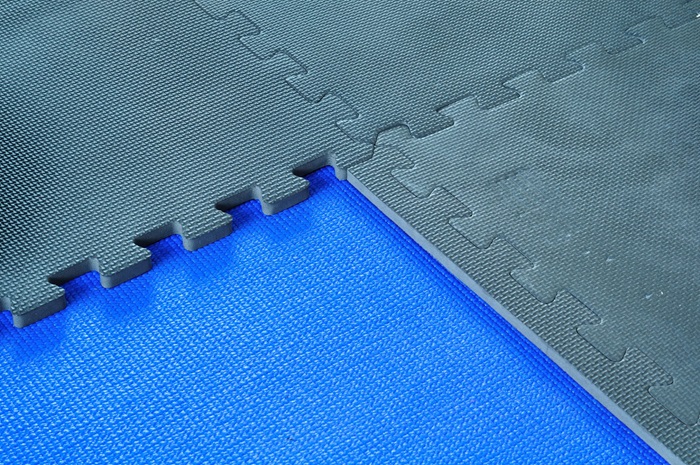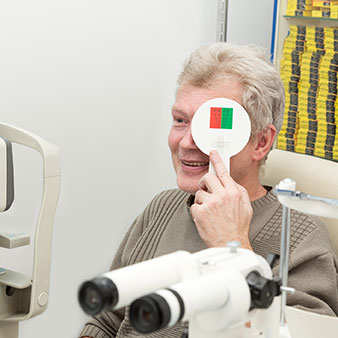What Floors Are Best to Work Out On?

September 25, 2020
Do you enjoy working out at home? If so, it’s important to consider the flooring that’s underfoot when you work out, because certain surfaces are less forgiving than others and may lead to injury.
To lower your chances of hurting yourself during workouts, exercise on the right kind of flooring and wear supportive footwear.
Exercise on softer surfaces
Compare the setup of your home exercise space to your gym’s layout and you’ll probably notice something that’s missing at home, aside from the long, mirrored wall.
“At the gym, [you’re probably] exercising on an elastic, pliable surface, usually rubber flooring,” says Sagar Parikh, M.D., an interventional pain medicine specialist at JFK Johnson Rehabilitative Institute in Edison. “At home, however, you’re typically working on a hardwood floor.”
Hardwood floors, concrete slabs (like basement floors) and other hard surfaces aren’t very forgiving on your joints. Figure out a way to make your workout space gentler on your body. Consider incorporating some mats or new flooring into your exercise area. Alternately, consider moving your workouts to a room in your home that already has a softer surface installed, such as carpeting.
Flooring choices that are ideal for workouts
If you’ll be working out at home for the foreseeable future, add flooring to your workout space that has some cushion or bounce, to be kinder to your joints. The best home gym flooring materials include:
- rubber
- foam
- low-pile carpeting
- vinyl
Rubber, foam and carpet flooring is often sold as 2-square-foot tiles that interlock like puzzle pieces; you may be able to buy as many or as few tiles as needed to cover your exercise space. Rubber, foam and vinyl are sold as mats or in rolls that can be laid out on the floor to cover your desired area. All of these materials should provide you with enough cushioning to protect your back, knees and other joints when you do high-intensity exercise.
“Anything to reduce the effects of that ground reaction force would be helpful,” Dr. Parikh says.
Wear proper footwear when exercising at home
At-home workouts probably feel casual. You may not change into your gym clothes, if you’re already wearing a T-shirt and sweats. You also might opt to skip lacing up your sneakers, if you’re accustomed to walking around the house barefoot or in socks or slippers. However, this is a step that you shouldn’t forget just because you’re home.
“When you’re at the gym or fitness studio, you’re more likely wearing sneakers,” says Dr. Parikh. “When engaging in at-home workouts, you may not think that needing some sort of cushion, or even foot protection like a sneaker, is needed, but it really is.”
The cushion and support that sneakers provide may help you avoid hurting yourself while you run in place, do step lunges, take a Zumba class or otherwise work up a sweat.
“Hitting a hard surface with your heel, or even the base of your bare foot, is typically not a good thing to do,” Dr. Parikh says. “[Sneakers provide] the necessary cushion needed, so that if I’m engaging in a high-energy exercise, I’m not hitting the floor hard and thus feeling the ground reaction force that will transmit to my ankles and to my knees and to my hips and then possibly even to my back.”
Find a doctor near me
Home Again After Stroke

Stroke recovery story: Find hope and support. Learn how Christina regained her life after stroke treatment at JFK Johnson Rehabilitation Institute. Call 800-822-8905.
Protect Yourself From Golfers’ Wrist

Prevent golfer's wrist pain. Learn how to manage and avoid this common golf injury with expert advice from orthopedic surgeons. Find relief today.
Find a doctor near me

Overcoming Quarantine Anxiety
If you are feeling anxious or burnt out from COVID-related stress and isolation, you aren’t alone.

What is Vision Therapy—and How Does it Help?
Improve vision & quality of life with vision therapy. Treat blurry vision, eye strain, and more. Learn how vision therapy can help you.

Five Tips for a Healthier Workout
Three of our cardiologists share how to fit heart healthy exercise into even the busiest schedules.

Tinnitus Patient Finally Finds Peace and Quiet
Find lasting tinnitus relief. Anna Callahan overcame constant ringing with innovative treatments at JFK Johnson Rehabilitation Institute. Learn how to manage your tinnitus today.
